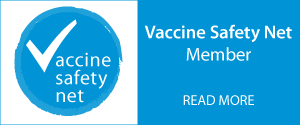Global Vaccine Data Network utilises vast data sets to detect potential vaccine safety signals
19 February 2024—The Global Vaccine Data Network (GVDN) assessed 13 neurological, blood, and heart related medical conditions to see if there was a greater risk of them occurring after receiving a COVID-19 vaccine. This was one of eight studies in the Global COVID Vaccine Safety (GCoVS) Project.
Recently published in the journal Vaccine, this observed versus expected rates study included 99 million people (over 23 million person-years of follow-up) from 10 collaborator sites across eight countries. The study identified the pre-established safety signals for myocarditis (inflammation of the heart muscle) and pericarditis (inflammation of the thin sac covering the heart) after mRNA vaccines, and Guillain-Barré syndrome (muscle weakness and changed sensation (feeling)), and cerebral venous sinus thrombosis (type of blood clot in the brain) after viral vector vaccines.
Possible safety signals for transverse myelitis (inflammation of part of the spinal cord) after viral vector vaccines and acute disseminated encephalomyelitis (inflammation and swelling in the brain and spinal cord) after viral vector and mRNA vaccines were identified. So far, these findings were further investigated by the GVDN site in Victoria, Australia. Their study and results are described in the accompanying paper.
Results are available for public review on GVDN’s interactive data dashboards.
Observed versus expected analyses are used to detect potential vaccine safety signals. These studies look at all people who received a vaccine and examine if there is a greater risk for developing a medical condition in various time periods after getting a vaccine compared with a period before the vaccine became available.
Lead author Kristýna Faksová of the Department of Epidemiology Research, Statens Serum Institut, Copenhagen, Denmark, remarked that use of a common protocol and aggregation of the data through the GVDN makes studies like this possible. “The size of the population in this study increased the possibility of identifying rare potential vaccine safety signals,” she explains. “Single sites or regions are unlikely to have a large enough population to detect very rare signals.”
GVDN Co-Director Dr. Steven Black states, “GVDN supports a coordinated global effort to assess vaccine safety and effectiveness so that vaccine questions can be addressed in a more rapid, efficient, and cost-effective manner. We have a number of studies underway to build upon our understanding of vaccines and how we understand vaccine safety using big data.”
GVDN Co-Director Dr. Helen Petousis-Harris states, “By making the data dashboards publicly available, we are able to support greater transparency, and stronger communications to the health sector and public.”
The GCoVS Project was made possible with support by the Centers for Disease Control and Prevention (CDC) of the U.S. Department of Health and Human Services (HHS) to allow the comparison of the safety of vaccines across diverse global populations.
About the Global Vaccine Data Network (GVDN)
Established in 2019 and with data sourced from millions of individuals across six continents, the GVDN collaborates with renowned research institutions, policy makers, and vaccine related organisations to establish a harmonised and evidence-based approach to vaccine safety and effectiveness. The GVDN is supported by the Global Coordinating Centre based at Auckland UniServices Ltd, a not-for-profit, stand-alone company that provides support to researchers and is wholly owned by the University of Auckland. Aiming to gain a comprehensive understanding of vaccine safety and effectiveness profiles, the GVDN strives to create a safer immunisation landscape that empowers decision making for the global community. For further information, visit globalvaccinedatanetwork.org.
Disclaimer:
This news release summarises the key findings of the GVDN observed versus expected study. To view the full publication in Vaccine, visit doi.org/10.1016/j.vaccine.2024.01.100. This project is supported by the Centers for Disease Control and Prevention (CDC) of the U.S. Department of Health and Human Services (HHS) as part of a financial assistance award totalling US$10,108,491 with 100% percentage funded by CDC/HHS. The contents
are those of the author and do not necessarily represent the official views of, nor an endorsement by, CDC/HHS, or the U.S. Government. For more information, please visit cdc.gov.
ENDS
Media inquiries: gvdn@auckland.ac.nz and communications@uniservices.co.nz



